If you’ve been feeling overwhelmed by the constant changes on Facebook and frustrated with a lack of solid results, you’re not alone. Many small to medium size business owners – even Fortune 500 companies – find it challenging to properly reach their fans and struggle to measure real monetary results from their Facebook marketing efforts…
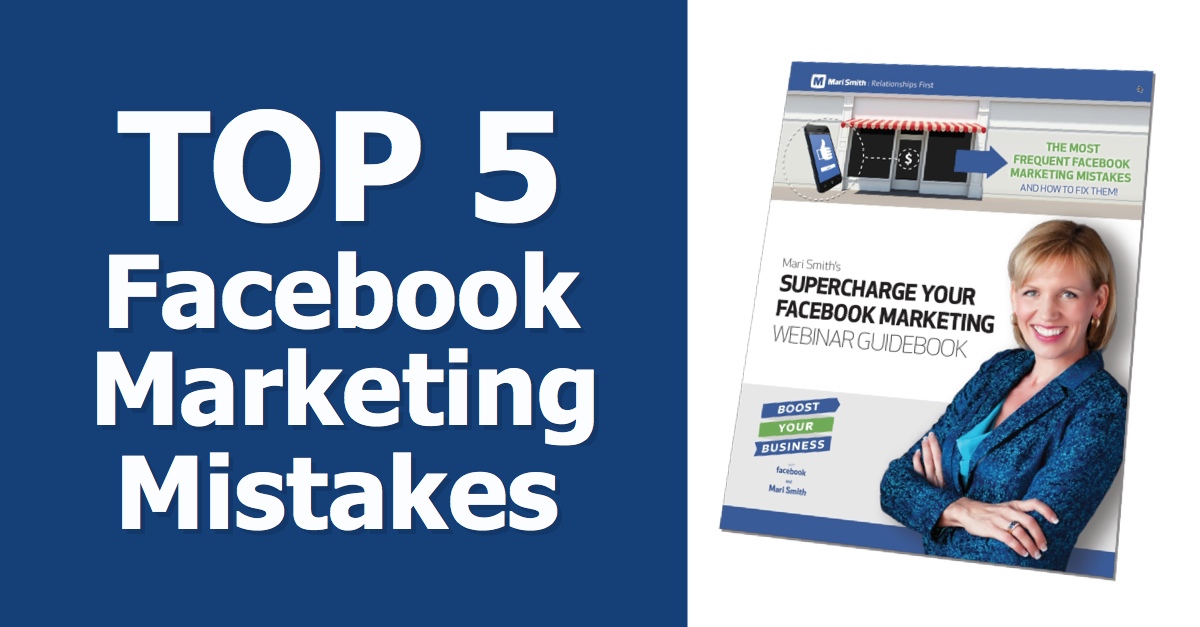
You’re more than likely making many, many mistakes on Facebook every single day that are costing you money… simply because you don’t know what you don’t know. Or, you’re using dated practices that no longer work.
It can be challenging to keep up with Facebook’s algorithm updates, but that’s what I’m passionate about – well that and helping businesses to create more success and growth through proven online and offline marketing strategies!
On that note, I’d love to meet you at one of the four major cities where Facebook is hosting a series of educational Boost Your Business events. I’m delighted to partnerdirectly with Facebook to help lead the series of half-day events.
In this post, I’ll walk you through what I’ve identified as the top five mistakes businesses make on Facebook – along with solutions and action steps for all five.
MISTAKE #1 – Not responding to fan posts and comments
Customers are posting twice as many messages that actually require a response from brands, yet five out of six of those messages go unanswered. [Source:SproutSocial.com]
A whopping 71% of complaints on social media are made on Facebook, compared to only 17% on Twitter, 6% on Google+, and 5% on Instagram. [Source: Edison Research & @jaybaer]
Socialbakers.com created a powerful metric called “Socially Devoted” to measure a brand’s response quotient, including how many questions they answer and how quickly they respond to customer posts.
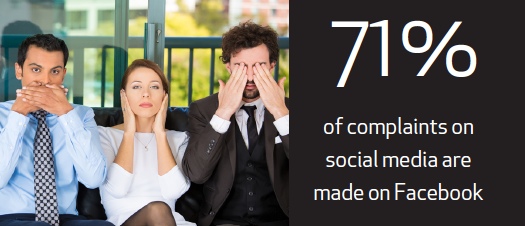
Solution:
Responding to posts and comments (ideally including all social activity and your blog),translates to money in the bank. People want to be heard and acknowledged. Depending on the size of your company, it may take a significant investment of resources to provide social customer support but it will pay off with the right trainingand approach.
Related mistake: Turning your Facebook Page WALL OFF. (Although this may be preferred for certain celebrities, major brands and highly regulated industries, in general, not allowing fans and visitors to post on your wall is an “old school” approach that shows you don’t want to hear from your audience unless you first have something to say!)
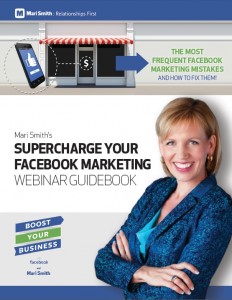 Join Mari Smith on a FREE webinar on May 19th to take a deeper dive into the TOP TEN Facebook Marketing Mistakes. When you sign up for the webinar, you’ll also be able to download the full-color PDF version of this blog post.
Join Mari Smith on a FREE webinar on May 19th to take a deeper dive into the TOP TEN Facebook Marketing Mistakes. When you sign up for the webinar, you’ll also be able to download the full-color PDF version of this blog post.Action Steps:
- Create a written policy for managing posts and comments by your audience on Facebook.
- Be sure to have a thorough process for how to manage negative comments and complaints.
- Consider using a simple in-house, color-coded system: Green = respond. Yellow = respond and invite to take the issue offline. Red = delete and possibly ban.
MISTAKE #2 – Your posts are overly promotional
If every post is all about you, your business, your products, your service and rarely about anything else, you could be having a detrimental effect. Granted, it may depend on your fanbase and their response, but if every Facebook Page post you publish contains a strong push to sign up, buy, visit your website, etc. you could be pushing some fans away.
Solution:
Be sure to check your “Negative Feedback” on posts. That is, how many hides, hide all, and unlikes you’re getting. You’ll want to experiment to find your own sweet spot, but a suggested ratio is 40:40:20.
- Forty percent value-adding, informational, educational content with little to no promotion.
- Forty percent promotional content with direct calls to action.
- And then twenty percent leeway to test off-topic, questions, polls, humor, etc.
Related mistakes:
- Posting too OFTEN.
- Posting too SELDOM.
- Posting uninteresting, IRRELEVANT or recycled content.
- Only posting the SAME types of content such as just photos and no videos or links.
Find out more about these mistakes on Mari’s free webinar.
Action Steps:
- Export your Facebook Page Insights (post data) for the past 90 days.
- Review column “R” which shows the total negative feedback count per post. (You can also review individual posts within the Insights dashboard to see the breakdown of negative feedback).
- Study the posts with the highest negative feedback and make adjustments as needed to your posting format, style, copy, frequency and timing.
MISTAKE #3 – Not having a budget for ads
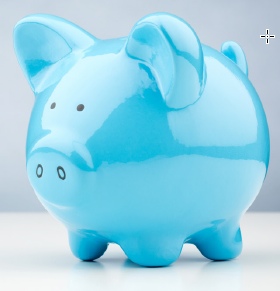 Let’s face it, we all know that the “good old days” of totally free marketing on Facebook are over. However, that doesn’t mean businesses have to invest a fortune to get solid, measurable results.
Let’s face it, we all know that the “good old days” of totally free marketing on Facebook are over. However, that doesn’t mean businesses have to invest a fortune to get solid, measurable results.Solution:
Facebook ads is still the most targeted traffic that your advertising dollars can buy. Even with a nominal budget (if you’re a super small business, up to $100 a week can make a huge difference), nowhere else online can you reach such a laser-specific type of audience than on Facebook.
But, it all boils down to properly understanding the tools and features available to you and integrating an effective strategy. Think about it this way, if you could get a 3x ROI every time you spent a dollar advertising on Facebook, wouldn’t it be worth it? Spend $100, get $300 in sales. With proper training and testing, you could see results significantly greater, such as 10x or 100x ROI!
Related mistake: Not being clear on the specific ROI goals you need to achieve. Learn more about these mistakes.
Action Steps:
- Set specific, measurable goals that you want to achieve (e.g. x number of website visits, leads, registrations, etc.)
- Allocate weekly ads budget within your means.
- Experiment with your paid posts (ideally within the Facebook Ads Manager or even Power Editor, if you can – see Mistake/Solution #4).
MISTAKE #4 – Using only the Boost button
 Certainly, the Boost button does help amplify your content but your content may perform a whole lot better with more granular targeting, placement and bidding.
Certainly, the Boost button does help amplify your content but your content may perform a whole lot better with more granular targeting, placement and bidding.
You have no doubt noticed that Facebook encourages you to use the Boost button at every opportunity. You’ll see notifications letting you know that a certain post is performing “better than 90% of all your other posts” and that you should boost it to reach even more. Some colleagues of mine call the boost button the “crack of Facebook.” With all due respect, it can be addictive. And you have higher reach numbers to show the boss (even if that’s you!).
Solution:
In order to maximize your reach to your ideal target audience, it’s important toutilize Facebook’s more powerful ad tools. Yet, it’s crucial to the financial success of your business that you are able to translate that higher reach into bottom line sales and profits – see next tip as well.
Related mistake: Not making full use of DARK posts. (This is paid content in the Facebook News Feed or right side column that look like Page wall posts but only appear as paid content and not on your wall. Much of the sponsored content in your News Feed is dark posts.)
Action Steps:
- Map out a solid Promotional Plan that includes a series of non-promotional, value-adding posts as well as posts with direct offers.
- Create written parameters of your target audience – be as specific as you can. (Many Facebook advertisers also have access to an extensive list of “Behaviors,” including purchase intent.)
- Decide in advance which posts you’ll chose to promote more granularly, including making use of dark posts.
Join Mari Smith on a FREE webinar on May 19th to take a deeper dive into the TOP TEN Facebook Marketing Mistakes. When you sign up for the webinar, you’ll also be able to download the full-color PDF version of this blog post.
MISTAKE #5 – Promoting posts without a measurable ROI
We have to admit, Facebook does an amazing job of tempting us to go after bigger numbers: more fans, more reach, more link clicks, more video views and just more, more, more.
However, time and again, I see promotional content in the News Feed that just doesn’t seem to be tied to an overall business building or conversion strategy at all. That telltale “Sponsored” label always indicates when a marketer is paying to get the content in front of our eyeballs. And, so often, the paid content just completely misses the mark.
For example, paying to boost pictures of your cat may not be the best way to show a real return on investment. That is, unless perhaps your business is gourmet kitty food or fluffy cat beds! LOL!
(Pic above from Instagram of my own adorable Bengal cat, Baby. I love to share photos and videos of her on my personal Facebook profile and Instagram… but wouldn’t pay to promote posts of her… okay, unless she had like a speech bubble with a CTA for an offer. Ha!)
Solution:
Again, this may be a personal choice for each Page owner. It may be if your objective is to increase reach and engagement, and then make an offer, your strategy could be different. However, it’s much more effective to plan out your weekly or monthly editorial calendar in advance, and strategically choose when you’ll post value-adding content vs. promotional offers, or a combination of both. (Learn more about this approach on my upcoming webinar.)
Action Steps:
- Ensure you set clear objectives (continue on from #3 above). Familiarize yourself with Facebook’s 10 advertising objectives – see screenshot below.
- Continuing on from #4 above, integrate these Objectives into phases of your Promotional Plan.
- Help yourself to these two free resource: Editorial Calendar +Social Media Marketing Promotion Calendar and Launch Plan.
To view the original article Click Here

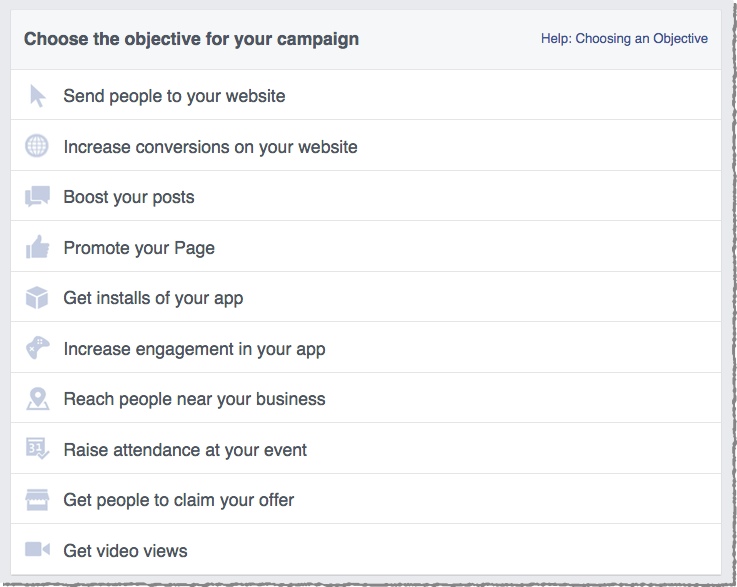
When someone interacts with your Facebook page, offer, event, etc. the action triggers Facebook posts, or “stories,” that the user’s friends may then see in their News Feed. These “stories” are generated naturally but are often buried in the News Feed. Opting for sponsored stories basically means you are paying to increase the likelihood that these stories will be seen. You can opt in or out of sponsored stories in the left column of the ad creator tool.
ReplyDeleteVery true Joseph. Thanks for commenting. (sorry about the late reply) :-) G
ReplyDelete